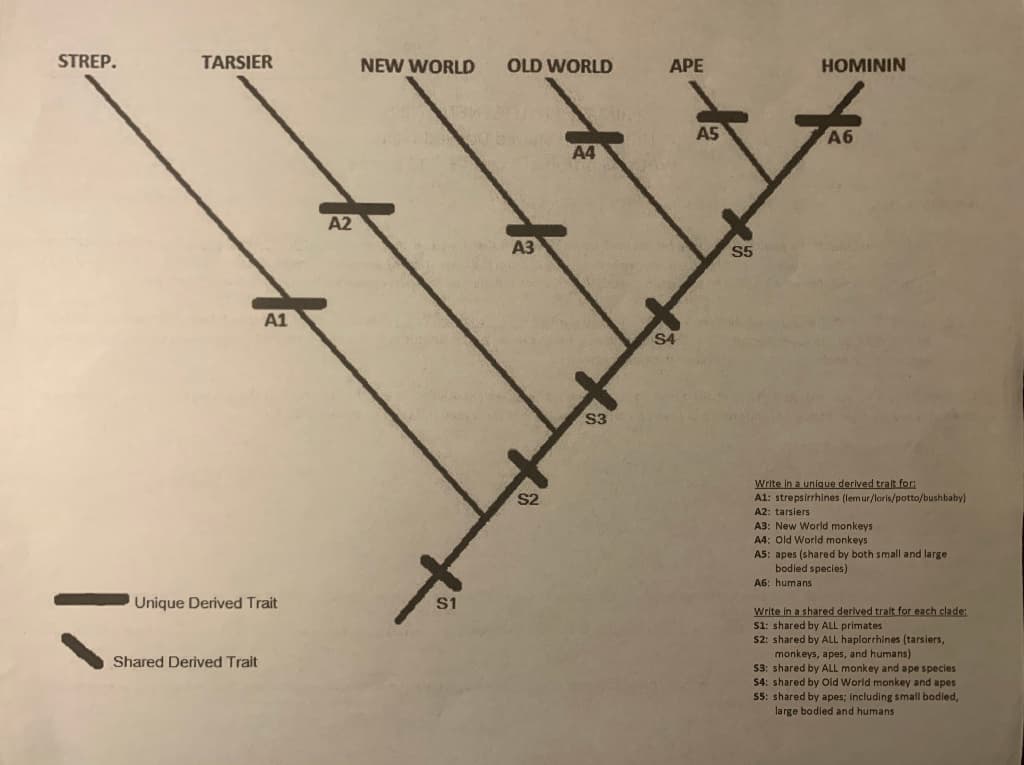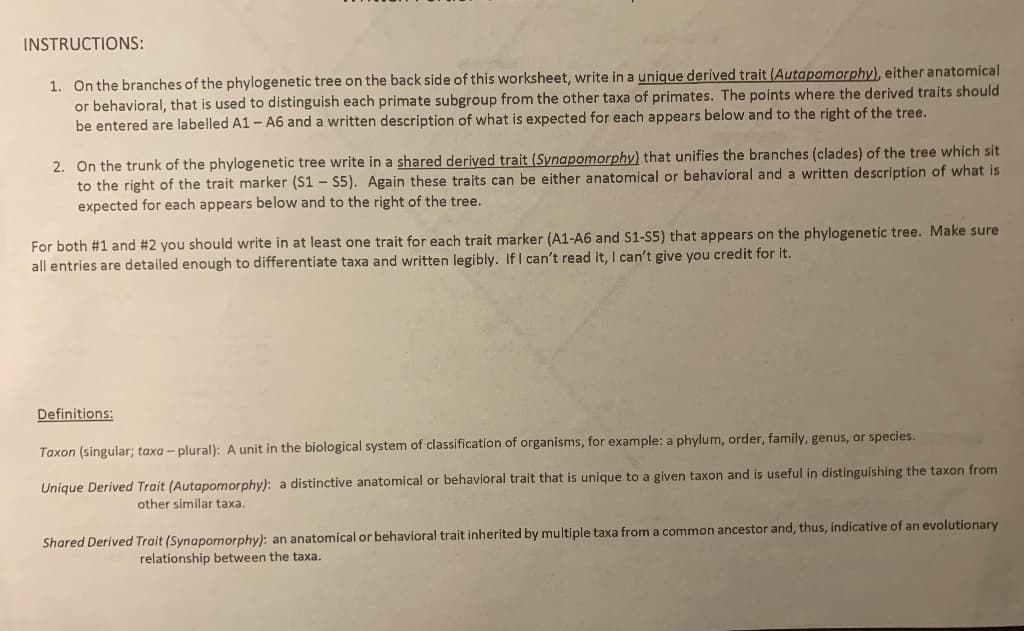Write in a unique derived trait for: A1: strepsirrhines (lemur/loris/potto/bushbaby) A2: tarsiers A3: New World monkeys A4: Old World monkeys A5: apes (shared by both small and large bodied species) A6: humans Write in a shared derived trait for each clade: $1: shared by ALL primates $2: shared by ALL haplorrhines (tarsiers, monkeys, apes, and humans) 53: shared by ALL monkey and ape species 54: shared by Old World monkey and apes S5: shared by apes; including small bodied, large bodied and humans
Write in a unique derived trait for: A1: strepsirrhines (lemur/loris/potto/bushbaby) A2: tarsiers A3: New World monkeys A4: Old World monkeys A5: apes (shared by both small and large bodied species) A6: humans Write in a shared derived trait for each clade: $1: shared by ALL primates $2: shared by ALL haplorrhines (tarsiers, monkeys, apes, and humans) 53: shared by ALL monkey and ape species 54: shared by Old World monkey and apes S5: shared by apes; including small bodied, large bodied and humans
Biology: The Dynamic Science (MindTap Course List)
4th Edition
ISBN:9781305389892
Author:Peter J. Russell, Paul E. Hertz, Beverly McMillan
Publisher:Peter J. Russell, Paul E. Hertz, Beverly McMillan
Chapter24: Systematics And Phylogenetics: Revealing The Tree Of Life
Section: Chapter Questions
Problem 12TYK
Related questions
Question

Transcribed Image Text:STREP.
TARSIER
A1
Unique Derived Trait
Shared Derived Trait
A2
NEW WORLD OLD WORLD
S1
A3
S2
A4
S3
APE
S4
↓
A5
S5
HOMININ
A6
Write in a unique derived trait for:
A1: strepsirrhines (lemur/loris/potto/bushbaby)
A2: tarsiers
A3: New World monkeys
A4: Old World monkeys
A5: apes (shared by both small and large.
bodied species)
A6: humans
Write in a shared derived trait for each clade:
S1: shared by ALL primates
S2: shared by ALL haplorrhines (tarsiers,
monkeys, apes, and humans)
53: shared by ALL monkey and ape species
54: shared by Old World monkey and apes
S5: shared by apes; including small bodied,
large bodied and humans

Transcribed Image Text:INSTRUCTIONS:
1. On the branches of the phylogenetic tree on the back side of this worksheet, write in a unique derived trait (Autapomorphy), either anatomical
or behavioral, that is used to distinguish each primate subgroup from the other taxa of primates. The points where the derived traits should
be entered are labelled A1 - A6 and a written description of what is expected for each appears below and to the right of the tree.
2. On the trunk of the phylogenetic tree write in a shared derived trait (Synapomorphy) that unifies the branches (clades) of the tree which sit
to the right of the trait marker (S1-S5). Again these traits can be either anatomical or behavioral and a written description of what is
expected for each appears below and to the right of the tree.
For both #1 and #2 you should write in at least one trait for each trait marker (A1-A6 and S1-S5) that appears on the phylogenetic tree. Make sure
all entries are detailed enough to differentiate taxa and written legibly. If I can't read it, I can't give you credit for it.
Definitions:
Taxon (singular; taxa-plural): A unit in the biological system of classification of organisms, for example: a phylum, order, family, genus, or species.
Unique Derived Trait (Autapomorphy): a distinctive anatomical or behavioral trait that is unique to a given taxon and is useful in distinguishing the taxon from
other similar taxa.
Shared Derived Trait (Synapomorphy): an anatomical or behavioral trait inherited by multiple taxa from a common ancestor and, thus, indicative of an evolutionary
relationship between the taxa.
Expert Solution
This question has been solved!
Explore an expertly crafted, step-by-step solution for a thorough understanding of key concepts.
This is a popular solution!
Trending now
This is a popular solution!
Step by step
Solved in 3 steps

Knowledge Booster
Learn more about
Need a deep-dive on the concept behind this application? Look no further. Learn more about this topic, biology and related others by exploring similar questions and additional content below.Recommended textbooks for you

Biology: The Dynamic Science (MindTap Course List)
Biology
ISBN:
9781305389892
Author:
Peter J. Russell, Paul E. Hertz, Beverly McMillan
Publisher:
Cengage Learning

Biology: The Dynamic Science (MindTap Course List)
Biology
ISBN:
9781305389892
Author:
Peter J. Russell, Paul E. Hertz, Beverly McMillan
Publisher:
Cengage Learning